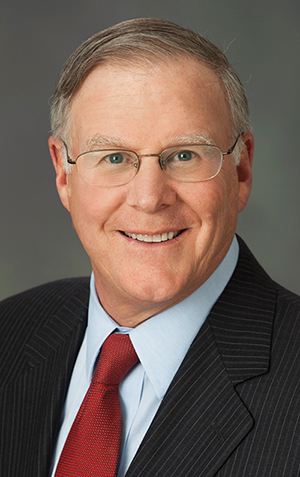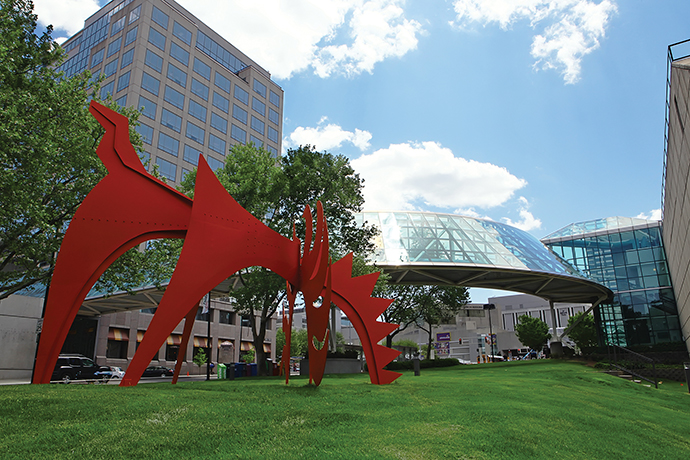Corporate leaders will tell you they don’t recognize artificial boundaries. What matters about any community, they say, is how well jurisdictions transcend city, county, state or provincial lines to function as a cohesive whole when it comes to the talent, infrastructure, supply chain, clusters and institutions that make up a thriving business ecosystem.
But if you’ve ever lived in a metro area overlaying multiple states, you know the meaning of territorial. Do companies benefit from such rivalries? Who lives out the promise of regionalism and who just pays it lip service? Are truces possible? Can everyone win a prize?
In Site Selection’s annual rankings of top-performing metro areas for corporate facility investment, a surprising number encompass multiple states — eight of the 30 metros across our Top 10s in three population tiers. Those eight include all three No. 1 metros last year: Greater Chicago, Omaha-Council Bluffs and Sioux City, where local leaders can take you on a drive that crosses into Iowa, South Dakota and Nebraska all within the space of 10 minutes.
But think of the cohesion challenges leaders face in those cities and more: Cincinnati (encompassing northern Kentucky and part of southwestern Indiana); Washington, D.C. (northern Virginia and Maryland); Charlotte (with the thriving area around Fort Mill, South Carolina drawing firms and families); New York (with lower-priced comeback cities in New Jersey beckoning from across the water); Memphis (with its warehouse cluster in Olive Branch, Mississippi); Quad Cities in Illinois and Iowa; Portland, Oregon (Vancouver, Washington).
My hometown, for better or worse, is Exhibit A.
I grew up in a place called Prairie Village, Kansas. It sounds bucolic, like it ought to have covered wagons and a blacksmith. But it’s really a well-positioned suburb, located in the state’s wealthiest and most well educated county (Johnson County), part of the Greater Kansas City metro area that encompasses, confusingly to outsiders, Kansas City, Kansas (known as KCK), and what most consider the principal city of the region: Kansas City, Missouri (KCMO).
My home was only a mile-and-a-half from State Line Road. Yes, rather than a river or ridgeline, a simple thoroughfare separates the two states, whose bitter rivalry from Civil War days still resonates. The Jesuit high school my brother and I attended stood directly on that road (Missouri side). Our sister’s high school, our family’s church and most of the stores we patronized were in Prairie Village or neighboring towns on the Kansas side. I could ride my moped (which in 1980 meant freedom to a 16-year-old suburban kid of limited means) the seven miles from Prairie Village to practice with my Ultimate Frisbee team the Ultimatoes on Liberty Memorial Mall in downtown Kansas City, Missouri, in about 20 minutes. On the way I’d pass through the famous Country Club Plaza shopping district and hip Westport district (both also in Missouri).
In that era, KCK had a reputation as a backwater. But it’s been thriving for a while now, thanks in part to state incentives that have helped boost tremendous corporate and mixed-use development. Chief among those programs is the Promoting Employment Across Kansas (PEAK) program, which offers qualified companies the ability to retain 95 percent of their payroll withholding tax for up to five to seven years). Missouri’s primary program today is Missouri Works, which helps expanding, job-creating businesses access capital through withholdings or tax credits, and can also help businesses purchase equipment to maintain their presence in the state.
Those two programs and the arsenals of others are often marshalled by the states in trying to lure a company across the line. Kansas City is the scarred battleground.
“To me, Kansas City is the No. 1 example of neighboring states competing aggressively for business investment,” says Adam Langley, a senior research analyst at the Lincoln Institute of Land Policy in Boston, and a co-author of the report "Rethinking Property Tax Incentives for Business." “It seems very wasteful. These incentives are just being used to move these companies back and forth across the state border. It’s not creating new jobs, it’s actually hurting residents of the region, and the vast majority of companies are not getting incentives.
‘To Nurture and Strengthen’
“The real geographic bases of economic activity are metro areas. State borders are kind of artificial,” Langley says. That artificiality is enhanced in KC. “The state border is just a road,” he continues. “It’s not like there’s a real division there. State and local governments understandably want to use every tool available,” he says, but the end result is simply a change in commute.

The most famous border-hopper of all was Applebee’s, which moved its headquarters from KCMO to suburban Overland Park, Kansas, in 2003; moved from there to Lenexa, Kansas, in 2007; then was lured back to KCMO in 2011 by a combination of Missouri Quality Jobs program incentives and city incentives. In 2015 the company finally moved its HQ out of the area altogether to Glendale, California, the L.A. suburb where the HQ of parent company DineEquity is located a safe four-hour drive from the Arizona line.
Sometimes a company is big enough to placate both sides by spreading the wealth. Cerner, the Kansas City, Missouri–based health-care IT giant, in 2009 took a U-turn from an intended major campus project at the old Bannister Mall site on the Missouri side to plant it in KCK instead. But a few years later it went forward with a separate megacampus at the mall site after all. Hallmark (where my father worked from 1969 until 1977) is another example, with a corporate HQ in downtown KCMO, but manufacturing and distribution operations in outlying municipalities on both sides of the line.
Mark Long is executive managing director and principal of commercial real estate advisors Newmark Grubb Zimmer in Kansas City, Missouri, and happens to be the son of former Hallmark corporate real estate executive Greg Long. He says regardless of the incentives skirmishes, “Kansas City is on a roll. We have quality people and low cost of business operations so we don’t ‘need’ incentives to the degree that some areas need them. We need to be in line with the market and compete with other states. Missouri and Kansas have similar tools and they are both equipped to land deals that are in play.”
Whether they’re needed or not, the tools are getting used. The Hall Family Foundation was created by Hallmark founder Joyce Hall, his wife Elizabeth and his brother Rollie in 1943, with an express purpose: “to nurture and strengthen the city they loved.” It was with that mission in mind that a study was undertaken several years ago to continuously document the ongoing cost to Kansas City of what Hall Family Foundation President Bill Hall calls the “economic border war.”

The latest figures show that, since 2009, 6,652 jobs have relocated from Jackson County, Missouri, to Wyandotte or Johnson County, Kansas, at a cost of $180 million in lost state income tax revenues. Going in the opposite direction, 5,126 jobs were relocated from Wyandotte or Johnson County to Jackson County at an abatement calculated at $131 million. The “net” jobs gain to the Kansas side of the state line totals 1,526, at a cost to the two states of $311 million.
“As they go back and forth, each state is losing in the process,” says Bill Hall (unrelated to the Hallmark founding family), who has a tall stack of documents about the issue on his desk. “We’ve had situations where we’ve been close to some kind of resolution, but we just haven’t had the right political climate. We are one city, divided by a state line. But when you go to the state capitals, they are all about the state and not about the city. So we end up with people who can literally move across the state line, do nothing more than turn right instead of left, and are paid enormous sums of money to do it.”
Hall understands how things work. It’s just a question of when enough people will view such forgiven taxes as unforgivable waste.
“In theory, there’s nobody who disagrees that it’s a waste of public money,” he says. “But when somebody is offering you that kind of money, and you have shareholders or family members, it’s awfully hard to say, ‘Well I’m going to pay more because it’s the right thing to do.’ When the two states are just waving money at you, in practice it’s awfully hard to turn down that money.”
Langley cites analysis by Tim Bartik at the Upjohn Institute that found that state and local tax incentives cost governments roughly $45 billion in 2015, and that the most revenue is forgone due to job creation tax credits, with property tax abatements being the second largest type of tax incentive.
After Finding Fault, Finding a Fix
There is plenty of blame to go around. Companies and their development attorneys can make a good living pitting one state against the other, Hall says, even by just threatening to move when the lease is up. On the government side, local city and county leaders like to keep the game going, he says, thinking that by sheer force of their personalities they’ll end up winning more jobs than they lose. But local politicians frequently have no stake in the game.

— Bill Hall, President, Hall Family Foundation
What might a truce look like? Missouri passed a law in 2014 that called for such a resolution involving four KC-area counties in each state, but Kansas did not accept the terms. Kansas Governor Sam Brownback in April 2016 proposed his own truce concept, but it was late in the Missouri General Assembly’s session and nothing came of it.
The Lincoln Institute’s Adam Langley says one solution deserves mention: KC’s regional and gridiron rival Denver, Colorado. “The area doesn’t span a border, but there are still lots of local governments that compete against each other,” says Langley. For the cities and counties and economic development organizations within the Metro Denver Economic Development Corporation, the explicitly stated first objective is to promote the region. Incentives are not off the board, but as one leader from the organization told me, those that go rogue “will be shunned.”
The Kansas City Area Development Council represents the bi-state metro area as a public-private economic development partnership, but steers clear of getting into state-vs.-state discussions, preferring instead to simply present all tools available and let companies make their own choices.
Langley also points to the Charlotte area as an example of two different approaches to economic development, with South Carolina more aggressive in incentive use, and North Carolina more focused on changing business-friendly fundamentals such as lower tax rates, high-quality services and infrastructure, a skilled workforce and reasonable regulations.
“In my view, there are a lot of good reasons to focus on those fundamentals,” he says. “Companies don’t need to worry about taxes going up when a tax incentive expires, and the overall business environment is stronger. That’s good for big and small companies, including so many that are not receiving incentives, but represent so many jobs in the region.”
“The topic of a truce is great in concept but difficult to manage when a real deal is in play,” says Newmark Grubb Zimmer’s Mark Long. “I think it requires a great deal of thought. KC leaders are really regional thinkers. And that has worked for us.”
Hall says past discussions have focused on prohibiting state flagship incentives programs from being used to help any company relocate within X number of miles of the state line within a prescribed KC metro area zone. But where to draw that line? The answer may come from methods already used by U.S. Census Bureau officials in defining metro areas themselves: commuter shed.
“To me," says Hall, "the key question has always been, ‘At what point would you begin losing employees because they wouldn’t drive the distance?’ ” He points to Topeka, Kansas, the state capital located about 64 miles and an hour-and-a-quarter’s drive from downtown KCMO, as an example. “If a firm moves from Topeka to KCMO, they’re moving for other reasons than incentives, because they’ll need a new workforce. Our average move in our study has been about two miles — that’s just a change in commute. You have the same workforce.”
Could now be the time to reconvene peace talks? “We don’t think right now the political climate is right,” Hall says. “It will be some day. It may be that people running for governor need to be quizzed on this before they run for office.”

